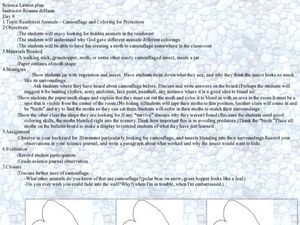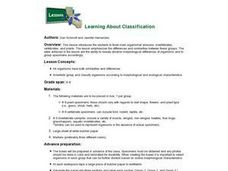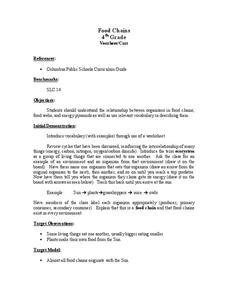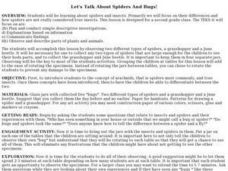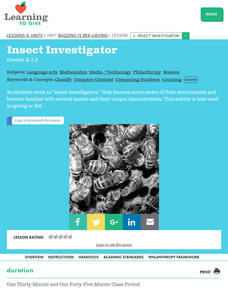Curated OER
The Importance of Observation
First graders practice observing items in small areas. In this scientific observation lesson, 1st graders complete a worksheet that shows a child looking at a small patch of grass. They make a list of items that the child sees. They...
National Park Service
Petrified Forest National Park
Poetry Soup, a reading and writing unit constructed by the Petrified Forest National Park, will have scholars hungry to learn about nature. The cross-content unit contains topics related to history, science, and language arts. Content...
Curated OER
Terrarium Observation
Students observe the growth of plants in their terrarium. In this social studies lesson plan, students measure plant growth for several weeks. They predict what happens if other organisms are added in the terrarium.
Curated OER
Catch as Catch Can
Students investigate insects. In this insect analysis lesson, students catch insects using nets they make. They identify the insects they catch and create a chart to show the numbers and varieties. This lesson includes a vocabulary list...
Curated OER
Crickets on the Hearth
Pupils investigate how crickets behave in cold temperatures. In this life science instructional activity, students explain the beneficial and harmful effect of pests. They research ways to properly manage them.
Curated OER
Think Safe! Be Safe!
Students predict, observe, and explain how pillbugs, grasshoppers, stink bugs, and humans stay safe and protect themselves.
Curated OER
Insect Unit
Fourth graders study the lives, and features of insects in the series of lessons that make up this unit.
Curated OER
Spelling and Thinking/ Short a
Pupils participate in a lesson that is concerned with the usage of spelling words that has the short "a" sound. They read the words in list form. Students also write the words in the "an" and "ad" word families.
Curated OER
Rainforest Animals – Camouflage and Coloring for Protection
Students explain why animals need to blend in with their surrounding. In this environmental science lesson, students create moth paper models to simulate animals hidden in the rainforests. They make a bulletin board display about what...
Curated OER
Positive/Negative Bugs
Bugs can be creepy - and fun! Kids create a positive and negative design by repeatedly drawing a simple insect overlaid with a geometric shape. The outcome is really neat and will help build spacial reasoning, visual acuteness,...
Curated OER
Food Chains
Learners take a look at the relationship between organisms in food chains, food webs, and energy pyramids. After an opening demonstration by the teacher, pupils are split up into groups. Each one is assigned an environment such as:...
Curated OER
What is an Insect?
Learners examine insects and identify physical characteristics of insects. They perform observations of insects, then use a worksheet imbedded in this plan to answer questions about them.
Curated OER
The Web of Life - Ecosystem
Students examine the concepts of ecosystems and interdependence. They construct block pyramids to demonstrate interdependence, and map off an area to observe and identify animals. They create food chain mobiles and play a web of life game.
Curated OER
Learning About Classification
Students explore the three main organismal divisions. Students classify organisms by invertebrates, vertebrates, and plants. They observe the differences and similarities between these groups.
Curated OER
Introduction To Insect & Spider Body Parts
Students inspect several different specimens of insects and spiders to determine characteristics that are similar and different between the two groups. They identify the basic body structure of spiders and insects and then predict where...
Curated OER
Arctic Food Web
Young scholars research animals found in the arctic. They discuss what living things need in order to survive and where they get their food. Students discuss the difference between producers and consumers and create a food web for...
Curated OER
"What Insecit Am I"
Students play the game "What Insect Am I" to explore the parts of an insect and their habitats.
Curated OER
Illinois Entice Spoken Here
Eighth graders name a prairie animal when their name is called for attendance each day. They read books about Illinois or related topics. At present we have read Illinois, A Rookie Read About Geography Book by Allan Fowler.
Curated OER
Food Chains
Fourth graders investigate food chains. They review cycles and discuss ecosystems. They select an environment and create a food chain in small groups. They write their food chain and label it for the class to evaluate. They create...
Curated OER
Vocabulary definitions
For this vocabulary words worksheet, young scholars read a fable and then they match the vocabulary words from the fable to their definitions. Students complete this for 8 words.
Cornell University
Insect IPM
Find out the characteristics that makes a bug an insect with a workbook designed to inform scholars about the crawly creatures that live around us. Scholars complete an ant-themed word search, answer questions using a solution key,...
Curated OER
Conservation in Small Spaces: Butterfly Life cycles
Students discuss ways that butterflies and moths change during their lifecycles, observe caterpillars, and explore how their different body parts work.
Curated OER
Let's Talk About Spiders And Bugs!
Second graders study the differences between spiders and insects. They observe four different specimens in the classroom.
Curated OER
Insect Investigator
Students examine and identify common insects. They observe these insects in their environment and keep track of how many they see. They use magnifying glasses and special hats to get into the role of an inspector.








